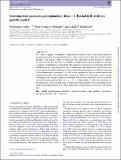Files in this item
Growing dust grains in protoplanetary discs - I. radial drift with toy growth models
Item metadata
| dc.contributor.author | Laibe, G. | |
| dc.contributor.author | Gonzalez, J.-F. | |
| dc.contributor.author | Maddison, S.T. | |
| dc.date.accessioned | 2014-09-09T13:31:05Z | |
| dc.date.available | 2014-09-09T13:31:05Z | |
| dc.date.issued | 2014-02-01 | |
| dc.identifier | 147009214 | |
| dc.identifier | bb524d05-a7d2-4126-9027-522ace1c30ff | |
| dc.identifier | 84891360020 | |
| dc.identifier | 000329177100001 | |
| dc.identifier.citation | Laibe , G , Gonzalez , J-F & Maddison , S T 2014 , ' Growing dust grains in protoplanetary discs - I. radial drift with toy growth models ' , Monthly Notices of the Royal Astronomical Society , vol. 437 , no. 4 , pp. 3025-3036 . https://doi.org/10.1093/mnras/stt1927 | en |
| dc.identifier.issn | 0035-8711 | |
| dc.identifier.uri | https://hdl.handle.net/10023/5397 | |
| dc.description | STM acknowledges the support of a Swinburne Special Studies Program. GL is grateful to the Australian Research Council for funding via Discovery project grant DP1094585 and acknowledges funding from the European Research Council for the FP7 ERC advanced grant project ECOGAL. JFG's research was conducted within the Lyon Institute of Origins under grant ANR-10-LABX-66. | en |
| dc.description.abstract | In a series of papers, we present a comprehensive analytic study of the global motion of growing dust grains in protoplanetary discs, addressing both the radial drift and the vertical settling of the particles. Here we study how the radial drift of dust particles is affected by grain growth. In a first step, toy models in which grain growth can either be constant, accelerate or decelerate are introduced. The equations of motion are analytically integrable and therefore the grains dynamics is easy to understand. The radial motion of growing grains is governed by the relative efficiency of the growth and migration processes which is expressed by the dimensionless parameter Λ, as well as the exponents for the gas surface density and temperature profiles, denoted by p and q, respectively. When Λ is of the order of unity, growth and migration are strongly coupled, providing the most efficient radial drift. For the toy models considered, grains pile up when -p + q + 1/2 > 0. Importantly, we show the existence of a second process which can help discs to retain their solid materials. For accelerating growth, grains end up their migration at a finite radius, thus avoiding being accreted on to the central star. | |
| dc.format.extent | 12 | |
| dc.format.extent | 1226324 | |
| dc.language.iso | eng | |
| dc.relation.ispartof | Monthly Notices of the Royal Astronomical Society | en |
| dc.subject | Hydrodynamics | en |
| dc.subject | Methods: analytical | en |
| dc.subject | Planets and satellites: formation | en |
| dc.subject | Protoplanetary discs | en |
| dc.subject | Dust, extinction | en |
| dc.subject | QB Astronomy | en |
| dc.subject | QC Physics | en |
| dc.subject.lcc | QB | en |
| dc.subject.lcc | QC | en |
| dc.title | Growing dust grains in protoplanetary discs - I. radial drift with toy growth models | en |
| dc.type | Journal article | en |
| dc.contributor.sponsor | European Research Council | en |
| dc.contributor.institution | University of St Andrews. School of Physics and Astronomy | en |
| dc.identifier.doi | 10.1093/mnras/stt1927 | |
| dc.description.status | Peer reviewed | en |
| dc.identifier.grantnumber | en |
This item appears in the following Collection(s)
Items in the St Andrews Research Repository are protected by copyright, with all rights reserved, unless otherwise indicated.

